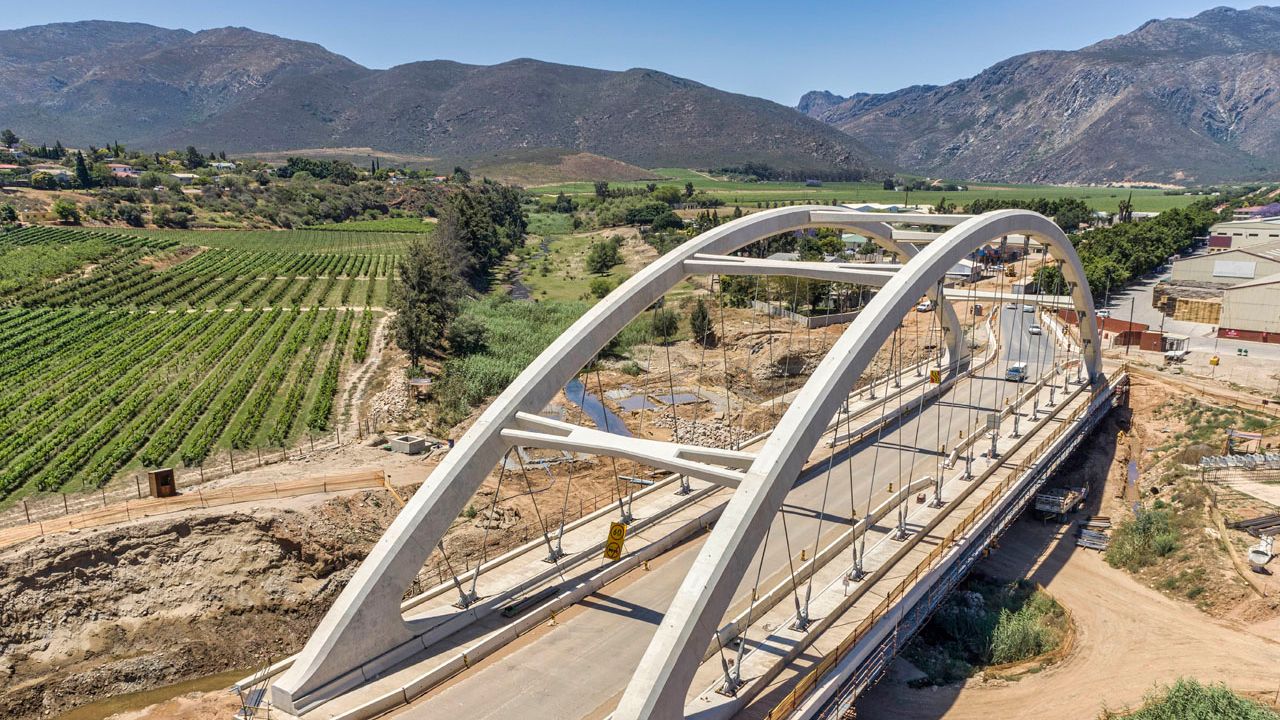2021
Western Cape
The newly completed Ashton Arch in the Western Cape is South Africa’s first concrete tied-arch bridge constructed using a transverse launching method. The bridge replaced an existing multi-arch bridge, which no longer fulfilled its functional requirements such as service life, width and hydraulic capacity. The new tied-arch bridge comprises a cable-supported concrete deck which spans 110 metres between supports with arching ribs rising 22 metres above the asphalt road surface.
Project Requirements
The greater Ashton-Montagu region, and Cogmanskloof Pass in particular, has experienced substantial flood damage on several occasions over the years. This resulted in multiple road closures and significant operational disruptions, with adverse impacts on the local economy. The flood capacity of the bridge, as well as its resistance to overtopping, needed to be addressed, along with traffic and pedestrian safety.
The selected final design of the bridge consists of a cable-supported concrete deck which spans 110 metres between supports with arching ribs rising 22 metres above the roadway. It has a single tied-arch structural configuration, where the typical cross-section of the arch bridge deck provides for four 3,4 metre traffic lanes and two 2,4 metre sidewalks. The twin parallel arch ribs are connected via 15,5 metre wishbone beams providing lateral stability to the arch ribs, post-tensioned tie-beams complete the arch structural form. This largely eliminated the possibility of debris build up and provided the shallowest deck depth option. Construction adjacent to existing bridge and transverse launching after completion minimized traffic disruption during construction.
Sika Solutions
To achieve a higher level of stability and safety on the temporary concrete support columns, SikaWrap®-300 C was specified for additional structural strengthening. This was used to encapsulate the head of the concrete support columns, using Sikadur®-330, a structural impregnating epoxy resin adhesive. Sika®CarboDur® FRP Design software, a state-of-the-art external structural strengthening design program was an exceptional added benefit.
The launching of the bridge from its constructed position to its final position required a perfectly levelled surface. This was achieved by using Sikadur®-42 ZA, high strength epoxy grout with high compressive strength and abrasion resistance. It can be applied in a thin layer, over a wide area, without having any shrinkage or cracking.
The ultra-high strength cementitious grout, SikaGrout®-295 ZA, typically utilized in the under-steel baseplate grouting of wind turbines on our local and international wind farms, was used in several vital applications. This included the grouting behind the anchor plates and jacking frames that created the permanent plinths for the permanent bearings. SikaGrout®-295 ZA was chosen for its ultra-high strength, 90-minute pot life and high flow properties that allowed it to be self-compacting and for easy application whether pumped or poured into place. The rapid strength gain of this product was critical to the progress of the project.
Interesting Facts
State-of-the-art bridge analysis software packages were used by AECOM’s complex bridge specialists for the design, construction stage and in-service analysis. This allowed an accurate simulation of the time-dependent material behaviour with the possibility of force adjustments during construction.
Using a transverse launching method of a completed concrete tied-arch road bridge is a first in South Africa where more than 8000 tons of concrete and steel was moved over 24 metres in less than 12 hours. Using Sika products, this one-of-a-kind task was made possible.
The dead weight at each abutment of 4000 tons was moved using the following equipment:
- Four 322 ton launching strand jacks
- Four pulling cables with 31 strands with a breaking force of 27 tons each
- Supplementary pulling capacity of two 120 ton jacks with 50 mm diameter stress bars
- Four temporary launch sliding bearings with 900mm diameter rotational pots.
- Four roller side guides to keep the bridge on track
To install the sliding and permanent bearings the 8000 ton deck had to be vertically lifted and lowered by H&I Construction. This was done in phases by installing the bearings at one abutment before repeating the process at the next. 12 No 500t hydraulic jacks were used for lifting and lowering the deck per abutment.
An extensive monitoring plan was prepared for construction and included system identification by full-scale dynamic testing as well as structural behaviour verification by deformation measurements, requiring continuous modelling and monitoring during all construction stages.
The successful completion of the New Ashton Arch Bridge resulted in a proud monument for the region. A first and unique application of this bridge engineering technique in South Africa.
Project Participants
Consulting Engineer
AECOM SA (Pty) Ltd
Main Contractor
Haw & Inglis Civil Engineering
Temporary Works Designer
Nyeleti Consulting
Support Cable and Prestressing Subcontractor
Amsteele Systems
Subcontractor
Allweld Marine & Industrial (PTY) Ltd
Form-Scaff
Concrete Supplier
Afrimat Readymix Cape (PTY) Ltd
Specialist Product Supplier
Sika South Africa (PTY) Ltd
Construction World Best Projects 2021
The New Ashton Arch Bridge Project was entered in 3 categories:
- Sika South Africa won in the Specialist Supplier category
- AECOM was highly commended in the Consulting Engineering category
- Haw & Inglis Engineering was highly commended in the Civil Engineering Contractor's category

